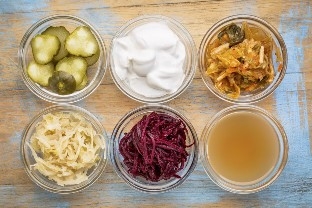Making Safe Fermented Foods and Beverages
ID
FST-435NP
History of Fermentation
From 3000 to. 4000 B.C.E., preserving foods and beverages through fermentation was needed for survival. Since then, they have evolved to become a popular hobby among consumers. (Hutkins, 2019). Discovery of fermented beverages was likely a happy accident, as berries and grapes and even milk was stored in clay or animal skin vessels. In the absence of refrigeration, these foods were transformed into new foods by millions of microscopic bacterial workers. In just a few days, leftover grape juice would become tangy or boozy as yeast in the air would transform the juice into wine (Hutkins, 2019).
While fermented foods and beverages have been present for thousands of years, they have only recently been produced on a large scale. During the start of the COVID-19 global pandemic, at-home fermentation practices became increasingly popular. This rise was due to more time for experimentation, and more education focused on the health benefits of fermented foods (Finkel, 2021). From creating sourdough starters, to fermenting tea for kombucha, at-home fermentations have become a popular hobby. The goal of this fact sheet is to outline general safety practices for the preparation and consumption of fermented foods and beverages.
What is Fermentation?
Fermentation: is defined as a process that takes place where bacteria or yeast convert sugars in raw agricultural products into a fermented product when little to no oxygen is present through the production of acids or alcohols. These products of the microbial workers preserve the nutrients in the food as it creates a habitat where spoilage microbes cannot thrive. Fermented products have properties varying from highly acidic to highly alcoholic depending on the raw commodity. For example, yogurt (an acidic fermented food) is created when bacteria break down sugars in milk. Alternatively, when yeast is exposed to grape juice, vinegar can also be created. (Hutkins, 2019).

Introduction of microorganisms to create a fermented product can occur in three ways:
Addition of Culture: To assure that the desired product is made fermenters may add microorganisms known to produce desired flavor and textures. Specific microorganisms in a concentrated liquid or powder are added to drive the fermentation process. Typically occurs in the food industry when you need a consistent fermentation because a new culture would be used for each batch. Example: adding bakers’ yeast in a dried form to create homemade bread (Hutkins, 2019).
Back-slopping: Live microorganisms from one fermented food are transferred to start fermentation of a new batch. Example: removing yeast from one batch of beer and transferring it to new batch of malt to begin the fermentation process (Dimidi et. al, 2019).
Wild: Natural microorganisms present on a raw product or in the air naturally drive the fermentation.
Importantly, this is the least consistent method of fermentation because it relies on the correct microorganisms being present. Additionally, unwanted spoilage could occur. Example: natural (safe) microorganisms present on cabbage drive fermentation during sauerkraut making (Hutkins, 2019).
Properties of Fermented Foods and Beverages
When thinking of different foods and beverages, different flavor properties may come to mind. For example, yogurt characteristically has a sour, tangy flavor, and beer (depending on the type) can have flavors that vary from toasty to bitter. While there are many factors that go into properties of fermented foods and beverages, the microorganisms used are one of the driving factors, and also why we care about safe practices.
The primary microorganisms used in food and beverage fermentations are yeast and bacteria. Importantly, the species and strain of these microorganisms used can significantly change not only the sensory properties, but the safety, as well.
Table 1: Properties of Fermented Foods and Beverages (Adapted from various sources, Hutkins 2019).
Enhanced preservation |
Enhanced nutritional value |
Enhanced functionality |
Enhanced sensory properties |
Uniqueness |
Increased economic value |
For example, lactic acid bacteria, the predominant bacteria used to make sauerkraut, creates lactic acid during fermentation, which is responsible for the sour, tangy flavor characteristic of sauerkraut. Additionally, this group of bacteria releases lactic acid which can prevent the growth of spoilage bacteria, which enhances the preservation of the product, and extends the shelf-life (Hutkins, 2019). In addition, when yeast converts sugars present into alcohol in fermentation to create products such as beer, the alcohol produced can prevent growth of harmful and disease-causing bacteria. (Hutkins, 2019).
3S Approach: Safety, Spoilage, and Shelf-Life
If considering an at-home food or beverage fermentation, it is best to follow good, hygienic practices to ensure that the fermented product can be enjoyed safely. Therefore, the following will describe the 3S Approach: Safety, Spoilage, and Shelf-Life. These three factors are critical when considering good preparation and handling practices in the planning of an at-home fermented food or beverage fermentation (Nummer, 2002, Hutkins, 2019).

Safety
Since fermentation occurs in an environment with little to no oxygen, this creates a safety risk due to some microorganisms that thrive in environments where oxygen is not present. Of main concern is Clostridium botulinum a species of bacteria that grows in oxygen free conditions and can produce deadly Botulinum toxin unless conditions such as high acid (pH below 4.6), salting, or refrigeration are maintained (Hutkins, 2019). Additionally, other disease-causing bacteria such as E. coli and Salmonella can survive if acid levels are too low and proper sanitations practices are not followed (Nwadike, 2015).
Therefore, crucial safety practices that must be followed when beginning a food or beverage fermentation are:
- Follow a verified recipe. For example, Virginia Cooperative Extension and other university extension publications are a great place to start when researching verified recipes for creating safe fermented foods and beverages. https://ext.vt.edu/food-health.html
- Wash all food-contact surfaces, preparer’s hands, and containers that will hold the fermented product. It is best practice to wash the containers in hot water with detergent, rinsing well, then air drying (Nummer, 2002). This will help to reduce the numbers of other bacteria and yeasts hanging out in the environment that will compete for food with the desired fermenters. The natural bacteria and yeasts may produce undesirable changes to the food and prevent the good bacteria from making enough acid or alcohol.
- Understand the process and desired outcome of the fermented food or beverage. For example, when making fermented vegetables or yogurt, the desired pH (acidity level) of the product should be below 4.6. pH can be tested using commercial pH strips (Nummer, 2002, Smith, 2015).
- Use undamaged raw products or prior commercially processed products. For example, to prevent spoilage and dangerous microorganisms from entering yogurt, it is necessary to use commercially, or at-home pasteurized milk (Nummer, 2002).Spoilage
The primary microorganisms of concern related to spoilage are molds and some yeasts. Not only can these microorganisms impact the appearance of a product, but they can impact sensory qualities, as well.
While some fermented products do have an extended shelf-life, it is important to understand signs that your fermented food and beverage may be spoiled, and ways that spoilage can be prevented.
Signs of spoilage are going to vary depending on the fermented food or beverage. For example, if brewing a beer at home, a common sign of spoilage is if the beer tastes like buttered popcorn due to the production of the chemical diacetyl (Harrison and Nummer, 2000, Hutkins, 2019).
The following are a few ways that spoilage can be prevented when creating a fermented food or beverage:
- Use properly cleaned and sanitized containers. This will prevent unwanted microorganisms from entering the product prior to fermentation (Harrison and Nummer, 2000).
- Observe the fermentation daily for unwanted aromas or appearances. For example, when brewing beer at home, it is important to monitor if the beer is becoming too cloudy or is producing unwanted off-odors which may signal spoilage (Harrison and Nummer, 2000).
- Ensure that an anaerobic (no oxygen present) environment is created depending on the product. If this is not monitored, exposure to oxygen can cause mold growth or in the case of beer production, it can result in vinegar flavors (Hutkins, 2019).
- Monitor the temperature of the fermentation depending on the verified recipe. For example, fermentation temperatures for beer vary from 46°F-59°F and 59°C to 72°F (Hutkins, 2019).
Shelf-Life
Arguably one of the most important benefits of fermented foods and beverages is that they increase the shelf-life of the product (Hutkins, 2019). Importantly, fermented foods and beverages are widely consumed because they take a raw product like for example, vegetables, and turn them into a product that will last longer.
In order to achieve the desired shelf-life of a desired fermented food or beverage, it is important to consider factors that may impact the long-lasting qualities of the product.
Best practices for making sure that the shelf-life of a fermented food or beverage is safe are:
- Follow the verified recipe exactly. For example, a product like sauerkraut requires a specific amount of salt (2.25-2.5%) (Hutkins, 2019). Too little salt can allow mold growth to occur resulting in a less desirable product with a lower shelf life (Eifert et. al, 2019).
- Check the pH (acidity level) of the product throughout the fermentation process. For example, when creating sauerkraut, the ideal pH of the finished product should be between 3.4 to 3.6 (Hutkins, 2019).
- Process the product (depending on what it is) in a boiling water canner so the products can be left at room temperature. Products like sauerkraut can be canned and process in this way, whereas products like beer will not (Eifert et. al, 2019). More information can be found on the Virginia Cooperative Extension publication 348-594, Boiling Water Bath Canning, Including Jams, Jellies, and Pickled Products.
- Store at the necessary temperature stated in the verified recipe. When making a fermented vegetable product like sauerkraut, the fermentation temperature should be between 70°F-75°F (Hutkins, 2019). If fermentation temperatures are high, (above 86°F) this can cause fermentation microorganisms to stop growing and allow spoilage microorganisms to take over (Krug, 2020, Eifert et. al, 2019).
References
Hutkins, Robert W. Microbiology and Technology of Fermented Foods. 2019. IFT Press. Wiley Blackwell.
Finkel, Ed. “Not Just a Gut Feeling.” IFT, 21 Nov. 2021, https://www.ift.org/news-and-publications/food-technology-magazine/issues/2021/november/features/not-just-a-gut-feeling.
Dimidi, Eirini, Selina Rose Cox, Megan Rossi, and Kevin Whelan. "Fermented Foods: Definitions and Characteristics, Impact on the Gut Microbiota and Effects on Gastrointestinal Health and Disease." Nutrients 11, no. 8 (2019): 1806. https://doi.org/10.3390/nu11081806. https://dx.doi.org/10.3390/nu1108180.
Nummer, Brian A. “Fermenting Yogurt at Home - University of California, Davis.” National Center for Home Food Preservation , Oct. 2002, https://ucfoodsafety.ucdavis.edu/sites/g/file s/dgvnsk7366/files/inline-files/295482.pdf
Nwadike, Londa. “Safely Fermenting Food at Home.” Kansas State University/University of Missouri , Sept. 2015, https://www.nifa.usda.gov/sites/default/files/resource/Safely%20Fermenting%20Food%20at%20 Home%20508.pdf
Smith, Diane K. “Yogurt Made Simple - NCSU.” Yogurt Made Simple, Washing State University, 2015, https://pubs.extension.wsu.edu/yogurt-made-simple.
Harrison, Mark A., and Brian Nummer. "Beer/brewing." Encyclopedia of Microbiology, Four-Volume Set (2000): 412.
Krug, Donna. “Taking a New Look at Fermented Foods .” Family and Consumer Sciences 2021 Annual Series , Kansas State University Research and Extension , June 2020, https://bookstore.ksre.ksu.edu/pubs/MF3491.pdf.
Eifert, Joell A, et al. “Vegetable Fermentation.” VCE Publications | Virginia Tech, 20 May 2020, https://www.pubs.ext.vt.edu/content/pubs_ext_vt_edu/en/FST/FST-328/FST-328.html.
Virginia Cooperative Extension materials are available for public use, reprint, or citation without further permission, provided the use includes credit to the author and to Virginia Cooperative Extension, Virginia Tech, and Virginia State University.
Virginia Cooperative Extension is a partnership of Virginia Tech, Virginia State University, the U.S. Department of Agriculture (USDA), and local governments, and is an equal opportunity employer. For the full non-discrimination statement, please visit ext.vt.edu/accessibility.
Publication Date
September 21, 2022



